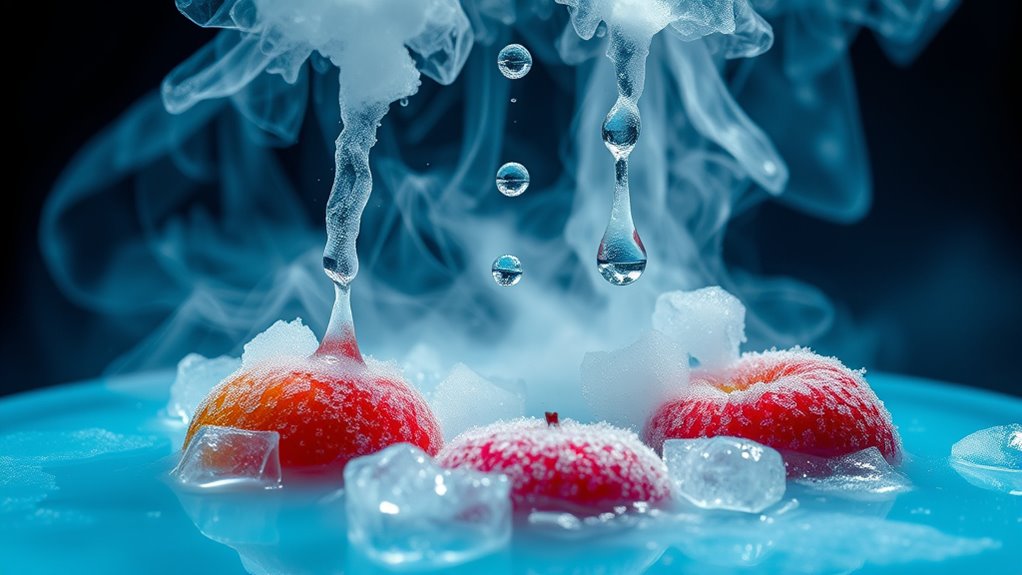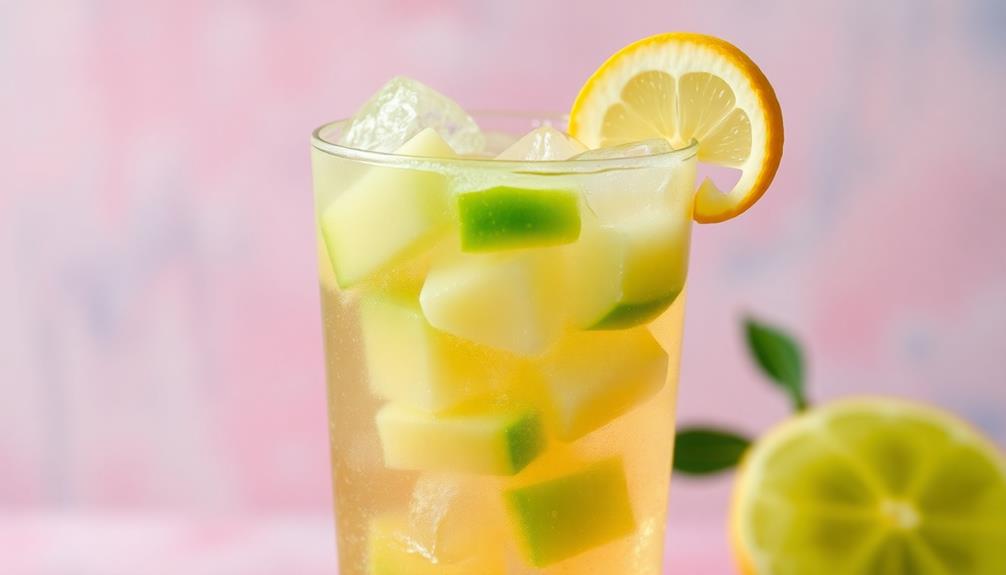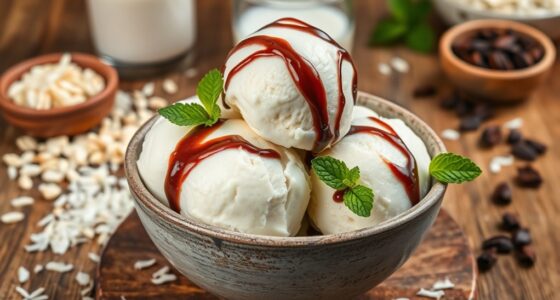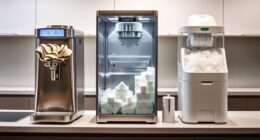Liquid nitrogen flash freezing is a fast method that preserves food by freezing it at -196°C, keeping its taste, texture, and nutrients intact. This technique creates smaller ice crystals, reducing damage compared to traditional freezing. It’s especially beneficial for high-value items like seafood and delicate fruits. While it offers rapid preservation, it also comes with safety considerations and costs. If you’re curious about the different techniques and applications, there’s much more to discover.
Key Takeaways
- Liquid nitrogen flash freezing rapidly freezes food at -196°C, preserving cellular structure and minimizing moisture loss.
- Smaller ice crystals formed during flash freezing help maintain taste, texture, and nutritional quality.
- Techniques like air-blast freezing tunnels and fluidized bed freezers optimize the freezing process for different food types.
- While effective, liquid nitrogen is more costly than traditional freezing methods, requiring careful cost analysis for businesses.
- Safety precautions, including PPE and proper ventilation, are essential when handling liquid nitrogen to prevent hazards.
Overview of Liquid Nitrogen Flash Freezing
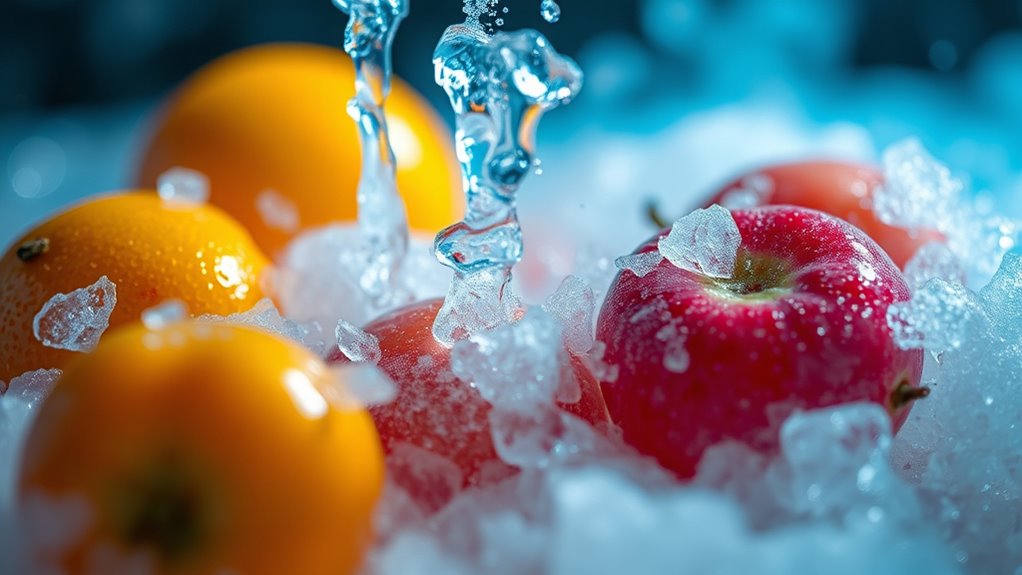
Liquid nitrogen flash freezing is a cutting-edge technique that rapidly freezes food at an astonishing -196°C. This method effectively preserves the cellular structure of perishable items, minimizing moisture loss and maintaining their taste, texture, and nutritional quality.
Unlike traditional freezing methods, liquid nitrogen creates smaller ice crystals, which helps prevent damage to the food. Additionally, liquid nitrogen freezers are compact, allowing you to optimize space in commercial settings.
However, keep in mind that while this technique is efficient, it does come with higher utility costs—averaging around 40 yen per kilogram compared to just 3 yen for liquid-based freezers.
Proper handling and safety training are essential to mitigate risks associated with the extreme cold of liquid nitrogen.
The Science Behind Flash Freezing

While many freezing methods can damage food’s texture and flavor, flash freezing stands out due to its ability to preserve cellular integrity. By using liquid nitrogen, which reaches temperatures as low as -196°C (-321°F), this technique guarantees rapid freezing with minimal moisture loss.
Here’s how it works:
- Smaller Ice Crystals: Flash freezing creates tiny ice crystals, reducing cell membrane damage.
- Fast Cooling Rate: The quick temperature drop prevents large ice crystals from forming, avoiding freezer burn.
- Nucleation Process: Impurities in food affect how rapidly ice crystals form, essential for ideal preservation.
This scientific approach not only maintains the taste and texture of food but also plays a significant role in preserving delicate biological samples in cryogenics.
Benefits of Liquid Nitrogen in Food Preservation

When you use liquid nitrogen for food preservation, you’re taking advantage of a rapid freezing process that locks in quality.
This technique minimizes moisture loss and forms smaller ice crystals, helping to keep your food’s taste and texture intact.
You’ll find that this method not only preserves the freshness of high-value items but also reduces spoilage, making it a smart choice for both home cooks and food industries.
Rapid Freezing Process
Using liquid nitrogen for flash freezing brings considerable advantages in food preservation, especially when it comes to maintaining quality.
By rapidly lowering food temperatures to -196°C, you can enjoy benefits like:
- Minimized Ice Crystal Formation: The quick freezing process prevents large ice crystals from forming, protecting cell membranes and retaining moisture.
- Faster Freezing Times: Liquid nitrogen freezes items in minutes, considerably outpacing conventional freezers, which can take hours.
- Extended Shelf Life: This technique enhances food safety by preventing spoilage, making it ideal for industries like meat packing and seafood.
Enhanced Food Quality
Liquid nitrogen flash freezing not only speeds up the freezing process but also greatly enhances food quality. By rapidly lowering food temperatures to -196°C, this technique preserves cellular structures and minimizes moisture loss, resulting in fresher products.
Unlike traditional freezing methods, liquid flash freezing forms smaller ice crystals, reducing damage to cell membranes. This means your food retains its original taste and texture, making every bite enjoyable.
Plus, nutrients stay intact, as the quick freezing process prevents degradation. You won’t have to worry about freezer burn either; large ice crystals won’t form, ensuring your food maintains its flavor and visual appeal.
It’s no wonder this method is essential for preserving high-quality items in the food industry.
Techniques for Flash Freezing Food

When it comes to flash freezing food, understanding the various methods and technologies is key to preserving quality.
You’ll find that techniques like the multi-station plate method and air-blast freezing tunnels each offer unique advantages for different food types.
Choosing the right equipment not only impacts freezing speed but also the overall texture and taste of your food.
Freezing Methods Overview
Flash freezing techniques play an essential role in preserving food quality and prolonging shelf life, as they quickly lower the temperature of items to maintain their cellular structure.
Here are three popular flash freezing methods:
- Multi-station plate freezing: This method places individual food packages on cooled metal shelves, ensuring even freezing without lumping.
- Air-blast freezing tunnels: These utilize controlled cold air to rapidly freeze packaged products on trays, ideal for high-volume food production.
- Fluidized bed freezers: By using strong airflow to suspend and freeze individual food items, this technique effectively reduces freezer burn while maintaining quality.
Each of these methods is tailored to different food types and production needs, showcasing the versatility of flash freezing in food preservation.
Equipment and Technology
For effective flash freezing, equipment and technology play a key role in optimizing the process. You’ll want to use liquid nitrogen freezers, which operate at around -196°C, greatly enhancing freezing speed. This rapid freezing occurs in just minutes, preserving food textures and nutrients better than traditional methods.
Since these freezers are smaller, they fit well in tight spaces, but remember to handle them with care due to safety risks associated with extreme cold. While liquid nitrogen can be more expensive than conventional freezing alternatives, it forms smaller ice crystals, minimizing moisture loss and maintaining quality.
Consider your long-term operational costs when choosing this advanced freezing technique to verify it meets your needs effectively.
Comparison of Freezing Methods

While various freezing methods are available, the choice between liquid nitrogen flash freezing and traditional liquid-based techniques can greatly impact food quality and preservation.
Here are three key points to evaluate:
- Speed: Liquid nitrogen flash freezing takes mere minutes, achieving temperatures as low as -196℃, while traditional methods can take an hour or more, affecting food texture.
- Cost: Utility costs for liquid nitrogen freezers typically average 40 yen/kg, compared to about 3 yen/kg for liquid-based options, making budgeting an important factor.
- Quality: Flash freezing minimizes moisture loss and reduces freezer burn, ensuring high-quality preservation, particularly for seafood and baked goods.
Ultimately, understanding these differences helps you make informed decisions for your food preservation needs.
Safety Considerations With Liquid Nitrogen Freezers
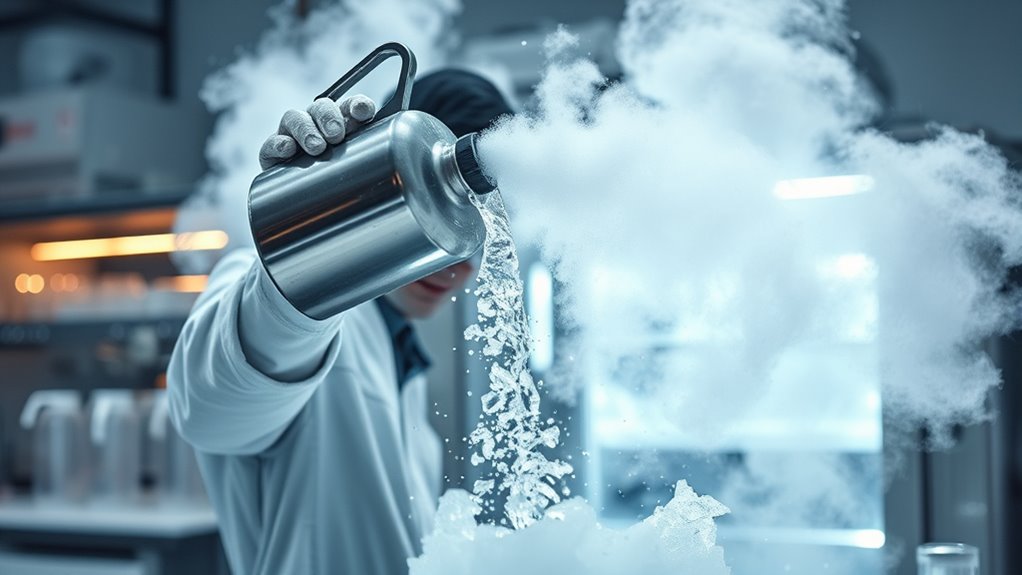
When working with liquid nitrogen freezers, understanding safety considerations is fundamental to prevent accidents and injuries. The extreme temperatures of -196℃ can cause frostbite or skin damage, so specialized training is important. Handle materials carefully, as they may become brittle and shatter during rapid freezing.
Proper ventilation is essential, as nitrogen gas can displace oxygen, creating suffocation hazards. Always wear personal protective equipment (PPE), including insulated gloves, face shields, and safety goggles, to protect against cryogenic burns. Regular maintenance and safety checks of your liquid nitrogen systems guarantee safety equipment functions properly.
| Safety Measure | Description |
|---|---|
| Proper Ventilation | Prevents oxygen displacement |
| Personal Protective Equipment | Shields against cryogenic exposure |
| Regular Maintenance | Guarantees functionality of safety equipment |
Cost Analysis of Flash Freezing Technologies
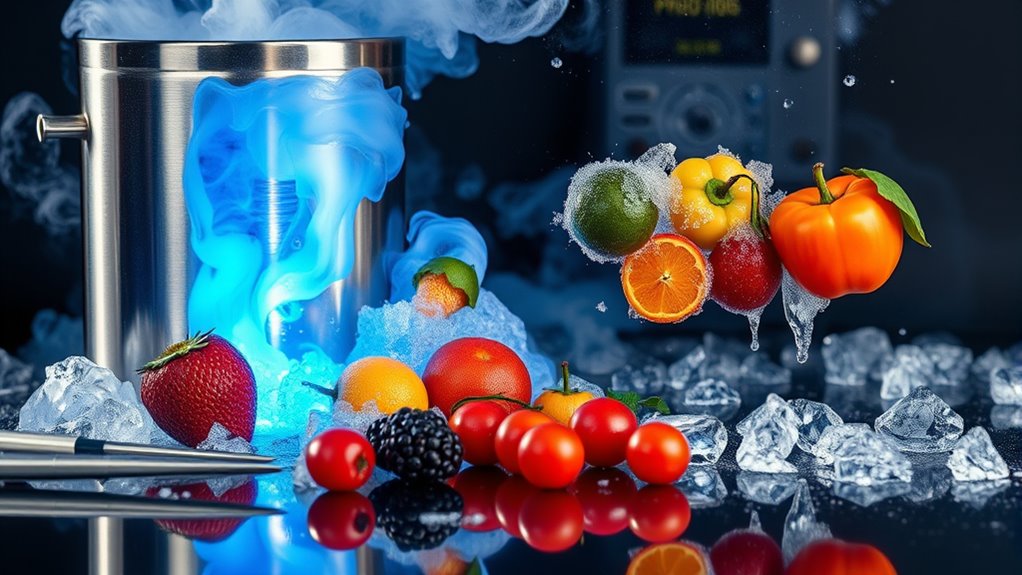
Understanding the costs associated with flash freezing technologies is essential for making informed decisions.
Here are three critical factors to weigh in your cost analysis:
- Liquid Nitrogen Prices: At around 40 yen per kilogram, liquid nitrogen is considerably pricier than the 3 yen per kilogram for traditional liquid-based freezers.
- Initial Investment: Purchasing a liquid nitrogen freezer can require a hefty upfront cost, influenced by size and customization.
- Ongoing Utility Costs: While offering rapid freezing, liquid nitrogen freezers typically incur higher utility expenses, demanding a thorough evaluation of long-term operational costs.
Applications of Flash Freezing in Various Industries
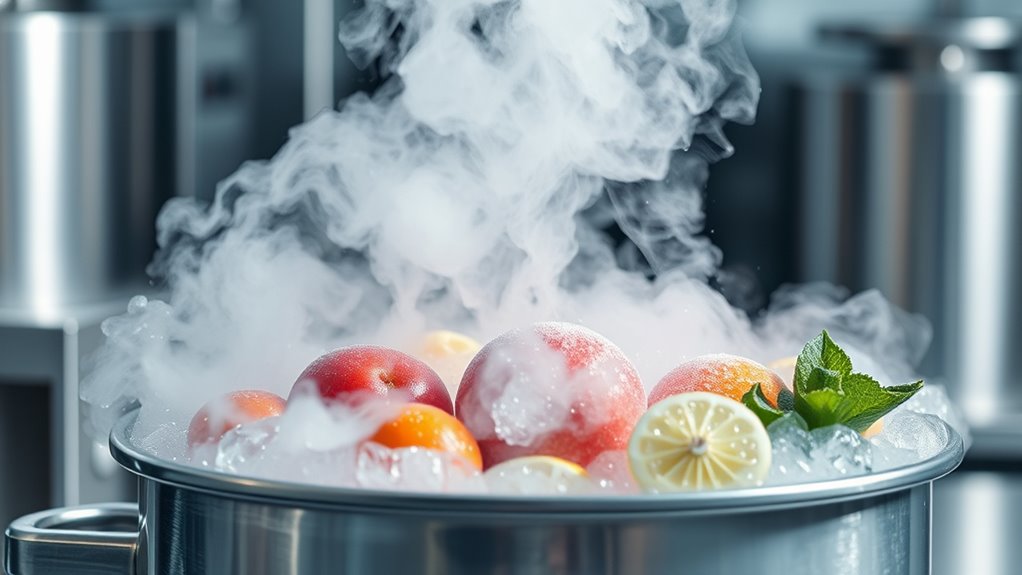
Flash freezing has revolutionized several industries by offering a rapid and efficient method for preserving the quality of various products.
In the food industry, you can flash freeze fruits, vegetables, and meats, ensuring they retain their taste and texture like fresh items.
Bakeries widely use liquid nitrogen to freeze dough and pastries quickly, keeping their structure intact for long-term storage.
The seafood sector benefits too, as flash freezing helps maintain the freshness of fish and shellfish, avoiding freezer burn.
In dairy, this technique contributes to smoother ice cream by minimizing ice crystal formation.
Additionally, in pharmaceuticals, flash freezing preserves biological samples and tissues, preventing damage to cellular structures, making it an invaluable tool across multiple industries.
Choosing the Right Freezing Solution for Your Business
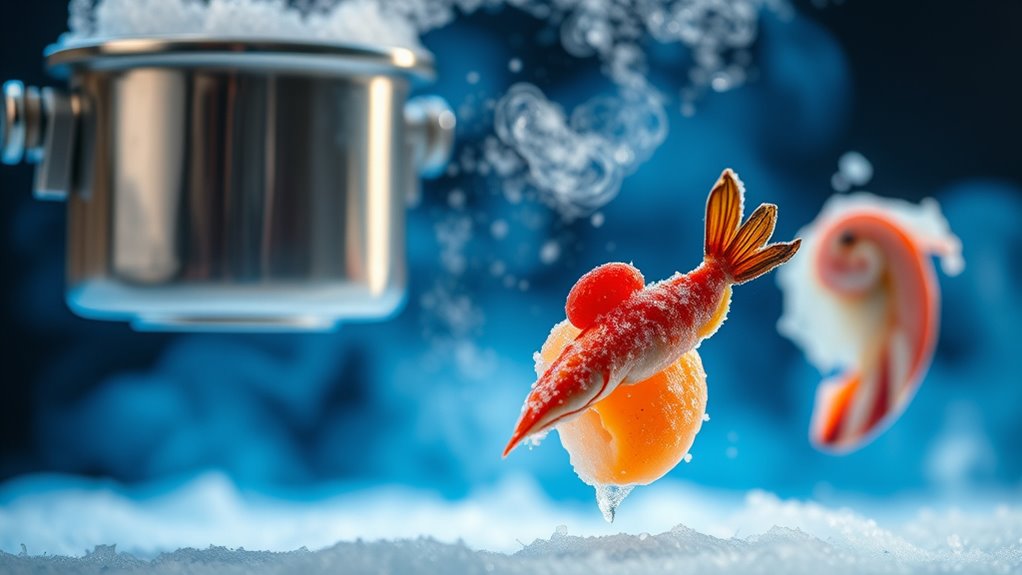
Choosing the right freezing solution for your business can greatly impact product quality and operational efficiency. Here are three key factors to evaluate:
Selecting an appropriate freezing solution is crucial for enhancing product quality and streamlining operations.
- Freezing Speed: Liquid nitrogen achieves rapid freezing at -196℃, preserving cellular structure and minimizing moisture loss better than traditional methods.
- Cost Efficiency: Liquid nitrogen freezers may have higher utility costs (about 40 yen/kg) compared to brine and alcohol-based solutions (around 3 yen/kg).
- Safety Risks: While liquid nitrogen poses potential hazards due to extreme cold, brine-based freezers offer a safer alternative for short-term use.
Assess these elements carefully to guarantee you make the best economic decision for your business.
For more tailored advice, don’t hesitate to contact us today!
Frequently Asked Questions
How Do You Flash Freeze Samples in Liquid Nitrogen?
To flash freeze samples, you start by preparing them in suitable containers that can handle extreme cold.
Next, immerse the samples in liquid nitrogen, ensuring they’re fully submerged. Keep them in liquid nitrogen for a few minutes to allow rapid cooling.
After freezing, transfer the samples to a cryogenic freezer to maintain their low temperature.
Always wear protective gear like gloves and goggles, as handling liquid nitrogen can be dangerous.
What Is the Flash Freeze in Liquid Nitrogen?
Flash freezing is like a superhero for your food, instantly preserving its freshness!
When you flash freeze something, you rapidly lower its temperature, creating tiny ice crystals that lock in taste and texture. This method prevents moisture loss, ensuring your items stay delicious and nutritious.
It’s a game-changer for maintaining quality, whether it’s fruits, vegetables, or meats. You’ll find that food retains its integrity much better than with traditional freezing methods!
What Is the Flash Freezing Method?
Flash freezing is a rapid freezing method that quickly lowers temperatures to preserve food and biological samples.
When you use this technique, you’re preventing ice crystal formation, which keeps the texture, taste, and nutritional value intact.
This method’s effectiveness lies in its speed, freezing items in seconds rather than hours.
It’s particularly beneficial for perishable goods like fruits and seafood, ensuring they stay fresh for longer periods without compromising quality.
Can You Eat Food That’s Been Dipped in Liquid Nitrogen?
Can you eat food dipped in liquid nitrogen? The answer’s a bit tricky.
If it’s properly prepared and not directly touching the nitrogen, you can enjoy it. But watch out! The extreme cold can cause serious frostbite if you’re not careful.
You’ll need to let it warm slightly before taking a bite to avoid burns. Make sure the food’s safe first, and you’ll experience a unique texture like no other!
Conclusion
To sum up, liquid nitrogen flash freezing is like a time machine for food, preserving freshness and flavor in an instant. This innovative technique not only enhances food preservation but also offers diverse applications across industries. By understanding the science and benefits of flash freezing, you can make informed decisions for your business. Whether you’re looking to improve food quality or explore new technologies, embracing liquid nitrogen can elevate your preservation game to new heights.
